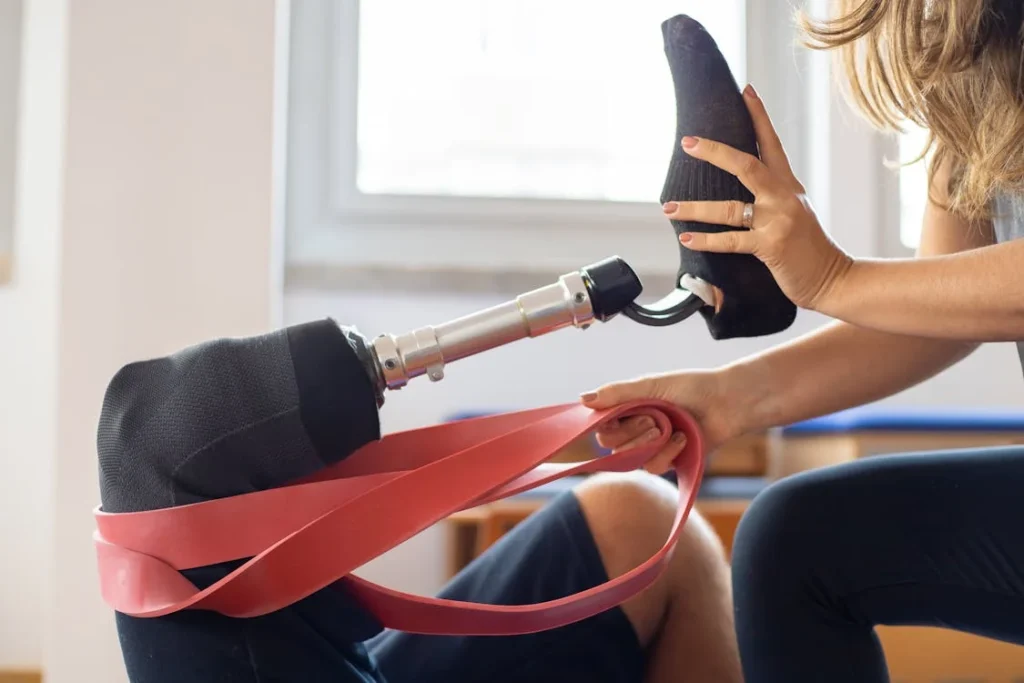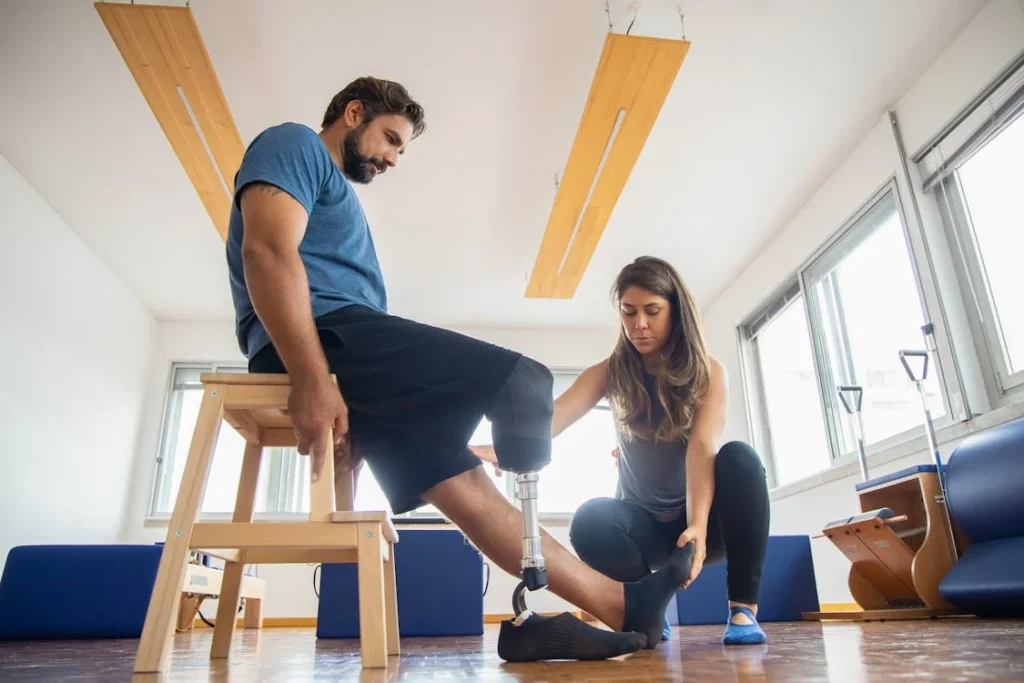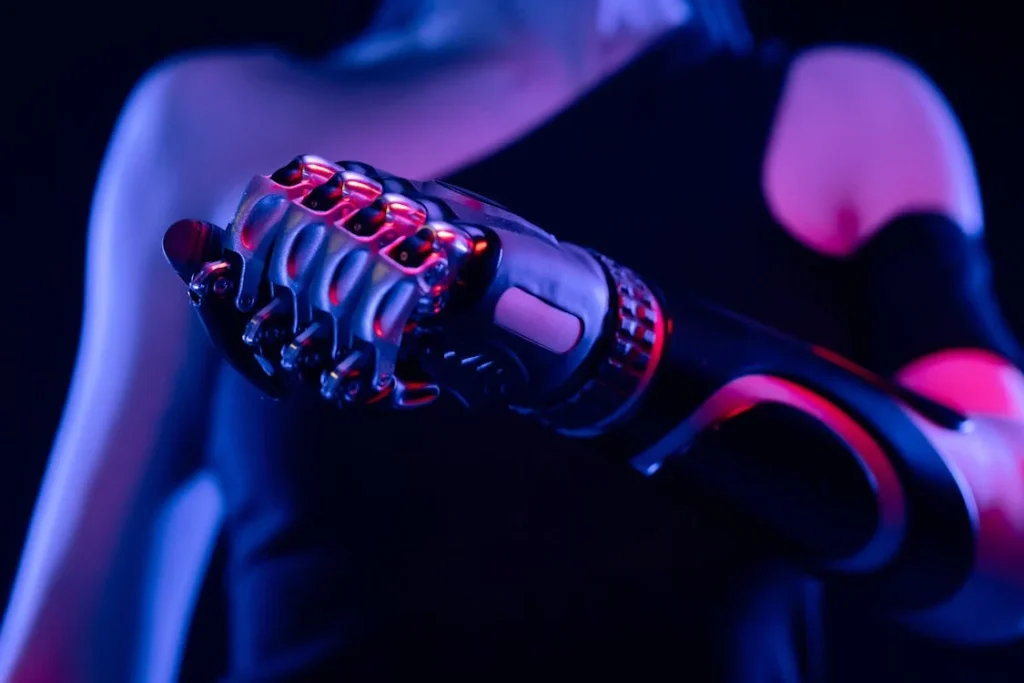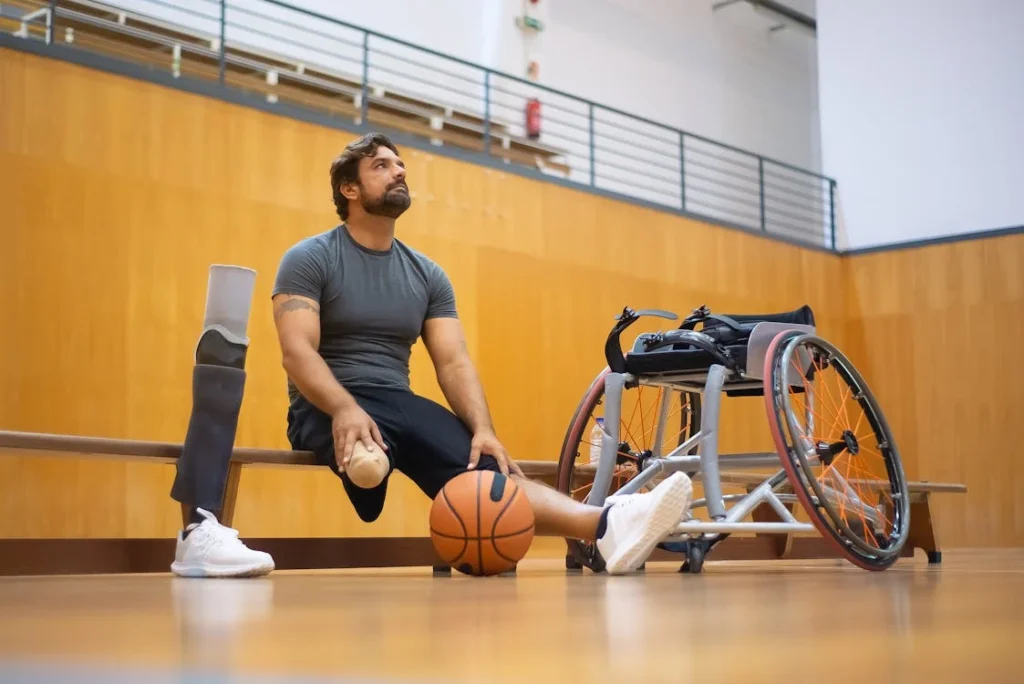Losing a limb changes everything, no matter how it happens. But how that loss happens makes a big difference in how the body and mind recover.
When someone faces a planned amputation—like due to a long-term illness, cancer, or poor circulation—there’s usually time to prepare. Doctors plan the surgery, talk about options, and help the person get ready both physically and mentally.
But limb trauma is different. It’s sudden. It comes out of nowhere. One moment you’re living your normal life, and the next, everything has changed. Recovery, in these cases, feels more like trying to catch your breath in the middle of a storm.

How the Body Responds: Physical Recovery Begins Differently
Trauma Leaves a Different Kind of Wound
When an amputation is planned, the body is prepared. The medical team knows exactly where and how to remove the limb to protect healthy tissue, shape the stump properly, and manage blood flow.
This careful approach gives the person a strong foundation for healing.
But in traumatic amputations, everything happens fast. An accident, explosion, or severe injury forces the body into crisis mode.
The wound is often messy, with torn muscles, damaged skin, crushed bones, and sometimes infection or heavy bleeding. Surgeons have to act quickly to save the person’s life, not just the limb.
This changes everything. The body has to work harder to heal. The wound site may not be as clean or balanced.
In some cases, doctors have to perform more than one surgery to remove dead tissue or reshape the stump later. That means recovery takes longer, and the path forward may feel unpredictable.
Pain and Swelling Stick Around Longer
Planned amputations usually have a smoother pain management process. Medication is given early. Doctors know what to expect, and they prepare for it.
The swelling is also easier to control because the tissue wasn’t damaged by trauma.
In traumatic cases, pain can be intense and last longer. It’s not just from the amputation itself—it’s from everything else the body went through during the injury.
There may be fractures, deep bruises, nerve damage, or burns around the limb. All of this adds layers of pain that take time and care to manage.
Swelling can also last longer. It’s the body’s way of protecting the injured area, but it makes it harder to fit a prosthetic early on.
This delay can slow down the process of learning to move again.
In both cases, pain is real—but how it’s treated and how the body reacts are very different depending on how the limb was lost.
The Residual Limb May Be Harder to Shape
After amputation, the leftover part of the limb—called the residual limb or stump—needs to be shaped and strengthened for prosthetic use.
With a planned surgery, doctors have more control over how the bone is cut and how muscles are sewn into place. This helps create a more stable and balanced shape, which fits better inside a prosthetic socket.
Trauma, on the other hand, often damages muscles, tendons, and nerves in unpredictable ways. Sometimes the injury destroys soft tissue, or the skin around the stump doesn’t heal evenly.
In these cases, it may take longer to reach the point where a person can try out a prosthetic. There might even be a need for a revision surgery to reshape the limb.
This doesn’t mean someone with a traumatic amputation can’t use a prosthetic. Many do, and they do it well.
But it often takes more time, more adjustments, and a little more patience to get the fit just right.
Infection Risk is Often Higher After Trauma
One of the biggest early risks after a traumatic amputation is infection. Because the injury happens suddenly—often outdoors or in an unsafe environment—dirt, debris, and bacteria can enter the wound.
If not cleaned and treated right away, infections can delay healing or cause more complications.
In planned amputations, the surgical environment is sterile. Doctors use clean tools, close wounds carefully, and give antibiotics in a controlled way. The risk of infection is much lower.
When infection happens after trauma, it can slow down every step of recovery. It might delay physical therapy, increase hospital time, or require additional treatment.
That’s why wound care is a major part of early recovery for trauma survivors.

Emotional Recovery: A Very Different Journey for the Mind
The Shock is Real—and Hits Harder After Trauma
When a limb is removed due to trauma, there’s no time to mentally prepare. It happens without warning. One moment life is normal, and the next, everything has changed. That kind of shock goes deep.
Many people who experience a traumatic amputation go through a state of emotional numbness in the beginning. It’s the brain’s way of coping.
Later, when things settle, the grief hits. And it’s not just grief for the limb—it’s grief for the life that was interrupted.
With a planned amputation, there’s often time to prepare mentally. Doctors and therapists talk to the patient ahead of time.
The person may have weeks or months to accept what’s coming. That doesn’t make it easy—but it gives space to adjust slowly.
Trauma survivors don’t get that time. Recovery starts in the middle of confusion, fear, and often, a lot of unanswered questions.
That’s why mental health care after traumatic amputation is just as important as physical healing.
PTSD is More Common with Traumatic Amputation
Planned amputations usually happen in controlled environments. The cause is often a medical condition like diabetes, cancer, or infection. While there is still emotional distress, it’s less likely to be tied to a single terrifying event.
In traumatic cases, the memory of the injury is often vivid. It may have involved violence, an accident, or witnessing harm to others.
These memories can stay stuck in the mind and lead to symptoms of post-traumatic stress disorder (PTSD).
Flashbacks, nightmares, anxiety attacks, or fear of certain places or situations are common. Some people try to avoid talking about what happened or keep their emotions hidden because it feels too overwhelming.
This makes it hard to focus on recovery. Someone may physically heal well but struggle emotionally for a long time.
Without the right support, PTSD can affect sleep, relationships, and motivation to use a prosthetic or return to daily life.
Talking to a mental health professional who understands trauma isn’t a sign of weakness—it’s a powerful step toward healing fully.
Self-Image and Confidence Take Different Paths
Any amputation affects how someone sees themselves. But how that process unfolds is very different depending on how the limb was lost.
In planned amputations, the person has time to imagine their body after surgery. They may already be living with a non-functional limb, so the change is physical but not as visually or emotionally sudden.
There’s often more time to prepare for how others might react and what kind of adjustments will be needed.
After trauma, the change in appearance is instant and shocking. Scars, wounds, or burns may be part of the injury. Some people avoid mirrors or social events.
Others may feel like they’ve lost a part of who they are—not just physically, but in terms of identity.
Rebuilding self-image takes time. It may start with small wins, like wearing regular clothes again or going outside for a walk.
Gradually, confidence builds—not just from physical recovery, but from moments of normalcy returning to life.
Support from family, peers, and even other prosthetic users can play a huge role. Seeing someone who has adapted well after a similar trauma can offer a kind of hope that no textbook or doctor can give.
Family and Social Support Looks Different Too
Families dealing with a planned amputation often have time to adjust. They can ask questions, learn about care routines, and prepare the home if needed.
This creates a more supportive environment right from the start.
But families of trauma survivors often feel the shock too. They may have seen the injury happen, or rushed to the hospital not knowing what to expect.
The sudden change affects them deeply. It can lead to confusion, helplessness, or even tension in relationships.
This doesn’t mean they care less. It just means they’re also grieving and adapting. Open communication is key.
Letting loved ones know what kind of help you need—and what kind you don’t—can reduce misunderstandings and strengthen support.
No one recovers alone. But the type of support, and the timing of when it’s needed, looks very different between planned and traumatic amputation journeys.

The Road to Rehabilitation: Timing, Tools, and Expectations
When Rehab Starts—and Why That Timing Matters
Rehabilitation is a big part of life after amputation, no matter how it happened. It’s the phase where you begin to rebuild strength, balance, and movement.
But the timing of when rehab starts can be very different depending on whether the amputation was planned or traumatic.
After a planned surgery, rehab is usually scheduled early. Doctors know what to expect, and the person is often ready to begin simple exercises within days.
The wound is cleaner, healing is more predictable, and pain is more manageable. Early movement helps reduce stiffness and speeds up the return to daily tasks.
With traumatic amputations, rehab may be delayed. There may be other injuries to deal with—broken bones, burns, internal damage, or infections.
The body needs time to stabilize. Some trauma survivors spend days or weeks in intensive care before they can even think about movement. The focus is survival first, then strength.
This delay doesn’t mean they can’t recover fully. But it does mean the process starts later, often from a place of deeper physical and emotional fatigue.
Rehab after trauma tends to require more patience—and more time.
Prosthetic Training May Take a Different Shape
When someone gets a prosthetic after a planned amputation, there’s often a clear plan in place. The team knows when the limb is ready for fitting.
The residual limb is well-shaped and healed. The patient may have already discussed prosthetic options before surgery.
But with trauma, there are often surprises. The shape of the stump may not support a standard socket right away.
Muscle damage or skin loss might mean that extra time is needed before fitting a device. In some cases, a temporary prosthetic is used first, just to get started with training.
Even once the prosthetic is fitted, the user might need more adjustments. A socket that feels perfect one day may feel wrong the next, especially if swelling goes up and down.
And because trauma can affect nerve endings, some users need extra time to build trust in how the prosthetic feels.
Training also focuses heavily on confidence building. After trauma, the fear of falling, hurting yourself, or being stared at can make someone hesitate.
A big part of early prosthetic use is helping the user feel safe—and then slowly pushing boundaries, step by step.
Emotional Readiness Affects Physical Progress
Many people think rehab is just about exercises, weights, and practice. But your emotional state plays a big role too.
Someone recovering from a planned amputation may feel focused and determined. They’ve had time to think about life after surgery. They may have seen other amputees and imagined how their own life could look.
This kind of mindset helps with rehab—especially in the early stages, where progress depends on motivation and patience.
For trauma survivors, the emotional side can hold things back. They might feel overwhelmed, depressed, or angry.
They may be grieving not just the limb, but the whole life that was lost in that moment. Some find it hard to trust their body again. Others may be afraid of pain, or embarrassed to try new movements in front of others.
Rehab professionals must meet people where they are—not just physically, but emotionally. Progress happens when the person feels safe, respected, and understood.
Small wins, like standing for a few seconds or taking a few steps with help, are huge turning points.
When the mind and body start to work together again, things begin to change faster.
Different Goals, Different Timelines
The goals of rehab can also look very different. Someone who’s had a planned amputation may want to return to the same lifestyle—same job, same hobbies, same routines. With a bit of time, this is often realistic.
But for someone who’s lost a limb through trauma, the injury might have also affected their work, their finances, or their community. The future may feel unclear.
Goals might start small—walking again, learning how to dress independently, feeling comfortable in public.
And that’s okay.
Setting the right goals isn’t about aiming low. It’s about meeting yourself where you are, then building from there. Each success becomes the next stepping stone.
As rehab continues, goals will grow. A short walk becomes a long walk. A walk becomes a jog.
Holding a spoon becomes cooking a meal. These are not just exercises—they are pieces of your life coming back.

Long-Term Adaptation: Living Beyond the Recovery Phase
Life Doesn’t Go Back—It Moves Forward
Whether a limb was lost through trauma or a planned surgery, there comes a moment when the initial recovery is over.
The wound has healed, the prosthetic is fitted, and the rehab sessions slow down. But this isn’t the end. It’s actually the beginning of something new: life after recovery.
This phase feels different for everyone. Some people want to return to their old routines as quickly as possible. Others feel the need to rebuild everything from scratch.
The key thing to understand is that life doesn’t “go back” to how it was. It moves forward—and your new normal might look different, but it can still be full, rich, and meaningful.
For trauma survivors, moving forward often comes with more unexpected hurdles. The trauma itself may leave deep emotional marks. You might feel fine one day, and overwhelmed the next.
You may struggle with sudden memories or flashes of what happened. You might feel restless, tired, or unmotivated even when everything around you seems fine.
This is normal. And it’s okay. The body can heal faster than the mind—and giving yourself time and space to adjust emotionally is just as important as keeping your physical progress going.
Finding Your Rhythm With a Prosthetic
Living with a prosthetic is not just about using it—it’s about living with it. That means building habits, creating comfort, and staying aware of your body as it changes.
In the beginning, everything is new. Putting on the socket, adjusting straps, managing skin care—all of it takes energy and attention.
Over time, these steps become part of your rhythm. You’ll know what time of day your prosthetic feels best. You’ll know when to rest, when to move, and when to take a break.
But this rhythm looks different depending on how the limb was lost. People with planned amputations might develop this routine faster because their recovery starts in a more stable place.
The stump is smoother, the healing is more predictable, and the body responds in a familiar way.
Trauma survivors often deal with shifting variables—nerve pain that flares up without warning, skin that’s sensitive in certain spots, or scars that stretch or tighten.
Their rhythm takes longer to find. And it may need to change often.
That’s why being flexible is important. Some days your body will need rest. Some days you’ll be able to do more than you expected. The point is to stay aware—and adjust when needed.
Returning to Work, Hobbies, and Social Life
Getting back to work or daily activities is a big milestone. It’s not just about money or responsibilities—it’s about feeling like yourself again.
For those who had a planned amputation, returning to work may have been part of the early plan. They might have discussed it with their employer before surgery.
Modifications or job changes may have already been set up. The return, while not always easy, is usually smoother.
Trauma survivors may not have that kind of head start. The injury might have changed their job completely.
They may need to learn new skills, switch careers, or take more time off than they’d hoped.
The same goes for hobbies. Activities that once felt simple—playing music, cooking, gardening, or driving—might feel out of reach at first.
But they’re not gone forever. With time, creativity, and sometimes adaptive tools, most hobbies can be enjoyed again.
The most important part is not to rush. If you’re not ready to return to work or a favorite activity, that’s okay.
Start small. Rebuild confidence. Every task you take back is a reminder that your life is still yours—and it’s still full of possibility.
Keeping Up With Long-Term Maintenance
Living with a prosthetic means staying proactive. Over time, your body will change.
Muscle shape, weight, and limb size can shift—especially in the first couple of years. This affects how your prosthetic fits and feels.
People with planned amputations may have fewer surprises here. Their residual limb is more stable from the beginning, and they may need fewer adjustments.
With traumatic amputations, maintenance tends to be more frequent. You may need socket changes, new liners, or tweaks to the alignment of the prosthetic.
That’s not a setback—it’s just part of the journey.
Stay connected with your prosthetist. Don’t wait until something hurts. Regular check-ins help catch small issues before they become big problems.
And remember to care for your skin and body every day. Clean your prosthetic. Keep the socket dry. Stretch your muscles.
All of this helps you move better and feel better, not just now—but for years to come.

The Power of Choice: Regaining Control After Amputation
When Everything Feels Out of Your Hands
One of the hardest things after limb loss—especially due to trauma—is the feeling that you had no say in what happened. The accident or injury came suddenly.
You didn’t get to choose. You didn’t get to prepare. And now, you’re trying to pick up the pieces of a life that feels unfamiliar.
That feeling of helplessness doesn’t just fade with time. It can linger quietly, even after the wound heals, even after rehab begins.
You may go through appointments, treatments, and routines feeling like things are being done to you, not done with you.
But recovery isn’t just about your body. It’s also about reclaiming your right to choose—what works for you, what doesn’t, and what kind of life you want moving forward.
Choice is a Form of Healing
Every small decision you make during recovery helps rebuild something important: your sense of self.
Deciding which prosthetic option feels best for your needs—not just the most advanced or expensive one.
Choosing when you’re ready to try walking again. Deciding what your rehab goals are, and how fast or slow you want to move.
These choices might seem small, but they carry weight. They remind your brain: I’m in charge again. And when you feel in charge, you’re more motivated.
You show up differently. You take ownership of your progress—not because someone told you to, but because it belongs to you.
That ownership becomes a kind of fuel. Even when progress is slow or frustrating, the fact that you chose this path gives it meaning.
Giving Input Builds Better Outcomes
Recovery involves many people—surgeons, prosthetists, therapists, family members.
Sometimes, they all have opinions. They want what’s best for you, but they may not fully understand what feels right to you.
That’s where your voice matters most.
Telling your prosthetist that a socket feels uncomfortable—even if it “should” be fine.
Letting your therapist know if a certain exercise brings up fear or anxiety. Explaining to your doctor that you’d prefer to wait a little longer before trying something new.
Being part of those conversations makes your care more effective. It turns your team into true partners—not just people doing a job, but people supporting your choices.
You don’t need to have all the answers. But the more you speak up, the more your recovery becomes something you’re building—not something you’re just going through.
Creating a Vision for Life After Recovery
There comes a point in recovery when the question becomes bigger than, “How do I heal?” It becomes, “What do I want next?”
And this is where your choices become the most powerful.
You might decide you want to travel again. Or learn a new skill. Or simply enjoy a quiet, balanced life with less pain and more comfort.
You might want to share your story someday—or never talk about it again. All of these are valid.
The point isn’t what you choose. It’s that you get to choose.
This can feel especially empowering for people recovering from traumatic amputation.
In a moment where so much was taken from you, creating your own future—even in small ways—becomes a form of resistance. A way to say: This didn’t define me. I’m defining what comes next.
Your choices are your anchor. They connect you back to yourself, your values, and your dreams.
And in a journey that often starts with loss, reclaiming choice may be the first real sign of freedom.

Culture, Community, and the Hidden Layers of Recovery
Healing Doesn’t Happen in Isolation
In many places around the world—especially in India—health and healing are rarely just personal experiences. They happen in the presence of family, in the middle of society, and under the gaze of cultural expectations.
When someone loses a limb, it doesn’t only affect the individual—it touches everyone around them. Parents worry, spouses adjust, relatives talk, and society observes.
And while community can be a source of support, it can also create pressure—sometimes quiet, sometimes loud.
Things like marriage, employment, body image, and even the ability to attend social events can become tangled in assumptions.
Some people feel judged for their appearance. Others worry about being seen as “less capable” or “incomplete.” These thoughts can carry more weight than the actual physical recovery.
Understanding this pressure is key to overcoming it. Because healing doesn’t just happen in the hospital or at the rehab center—it happens in living rooms, markets, weddings, and workplaces.
It happens in how you’re treated by others, and how you respond to that treatment.
Family Support Is Powerful—But Can Be Complicated
Family is often a central part of life in India and many other cultures. After an amputation, family members may step in to help with everything—from dressing and cleaning, to emotional care and financial support.
This closeness can be a blessing. It means you’re not alone. You have people looking out for you, watching over your recovery.
But it can also come with unspoken expectations. You might feel pressure to recover faster so your family isn’t burdened.
Or to act strong even when you’re not. In some cases, family members may overprotect you—discouraging you from taking risks, even when you’re ready.
It’s okay to feel conflicted. Gratitude and frustration can exist at the same time. What matters is finding your voice within that dynamic.
Let your family know how they can truly support you—what you need more of, and what you need less of.
A well-informed family becomes a bridge—not a barrier. Education helps. Involving them in prosthetic training or therapy sessions can show them what’s possible, and replace fear with understanding.
Facing Stigma in Public Spaces
In some communities, disabilities are still misunderstood. A missing limb may draw unwanted attention. Strangers may stare, ask questions, or assume you can’t do certain things.
This can lead to isolation—not because you can’t go out, but because it’s emotionally exhausting to always be seen as “different.”
Some people avoid public places for this reason. Others hide their prosthetics. It’s a quiet form of survival—but it can take a toll.
The only way to shift this narrative is by showing up, little by little, and living fully on your own terms.
Each time you walk into a room, attend an event, or speak about your experience, you’re challenging outdated beliefs.
And while you’re not responsible for educating the world, your presence alone is a kind of silent teaching.
It shows others that life after limb loss is not the end. It’s a different kind of beginning.
Connecting With Others Who’ve Been There
One of the most powerful ways to move through cultural or social pressure is to connect with people who truly understand what you’re going through.
Finding a community of other amputees—whether online or in your area—can offer relief, guidance, and a sense of belonging that no textbook or professional can provide.
You learn that your experience is not rare. Your feelings are not unusual. And your future can still be full of laughter, love, and purpose.
In many cities across India and beyond, small support groups are forming. WhatsApp groups, social media circles, and community meetups are quietly creating safe spaces where people share tips, struggles, and wins.
If you ever feel alone, seek these out. Sometimes, just hearing someone else say, “I felt that too,” is enough to shift your entire mindset.
Conclusion
Recovery after limb loss is never easy—but how that loss happens shapes everything that follows. A planned amputation gives space for preparation, while trauma demands immediate survival. The healing paths may look different, but both deserve care, patience, and dignity.
Trauma often brings deeper physical wounds, emotional shock, and longer uncertainty. Planned surgery brings its own challenges, but with more control and predictability. Neither path is better or worse—they’re simply different journeys.
What matters most is how each person is supported, empowered, and included in their own recovery. From physical rehab to emotional healing, from family dynamics to cultural pressures, every layer plays a role.
Recovery isn’t just about movement. It’s about meaning. About choosing your path, shaping your identity, and living life on your terms again.
No matter how you got here, your story doesn’t end with loss. It begins with what you do next.



